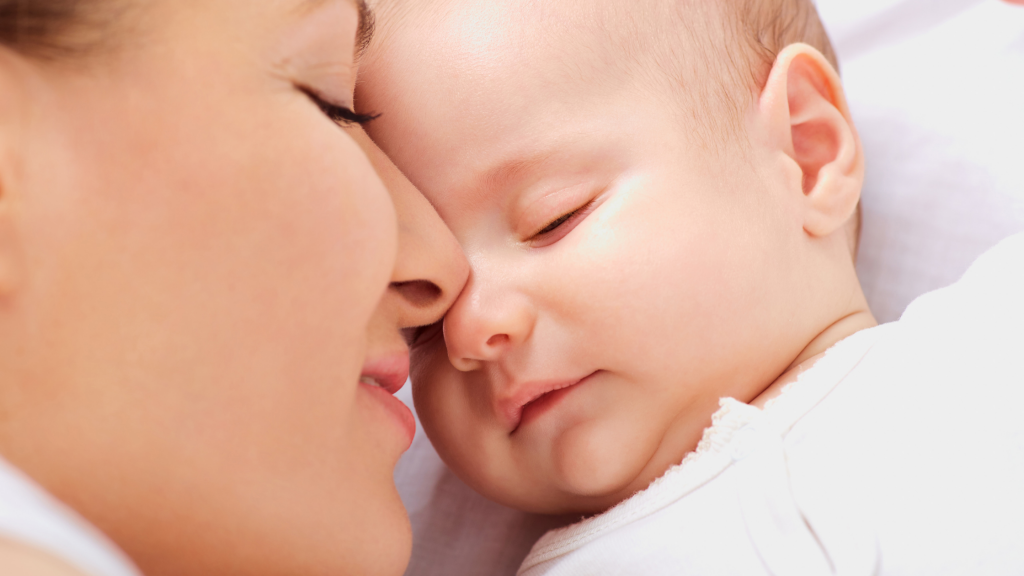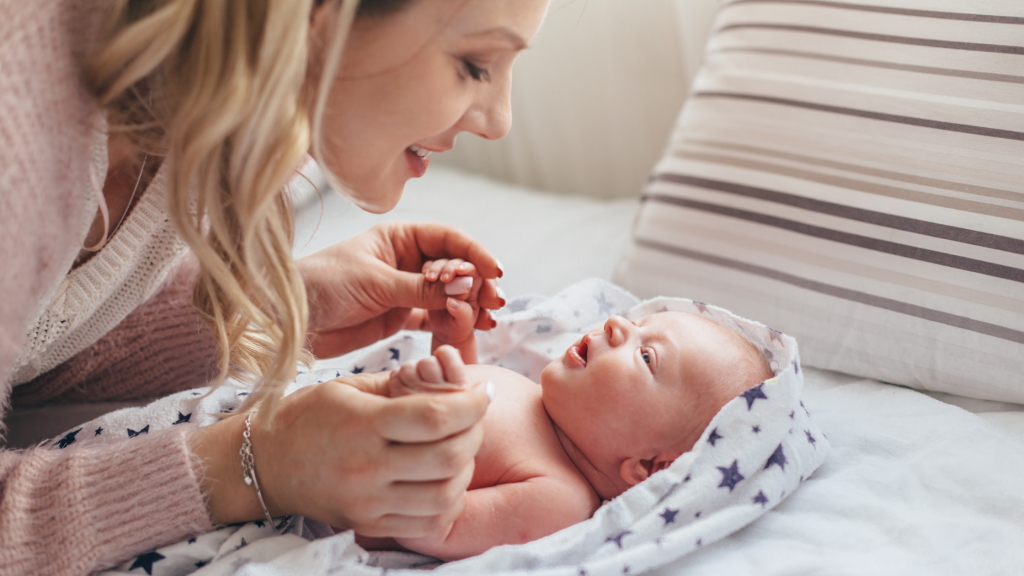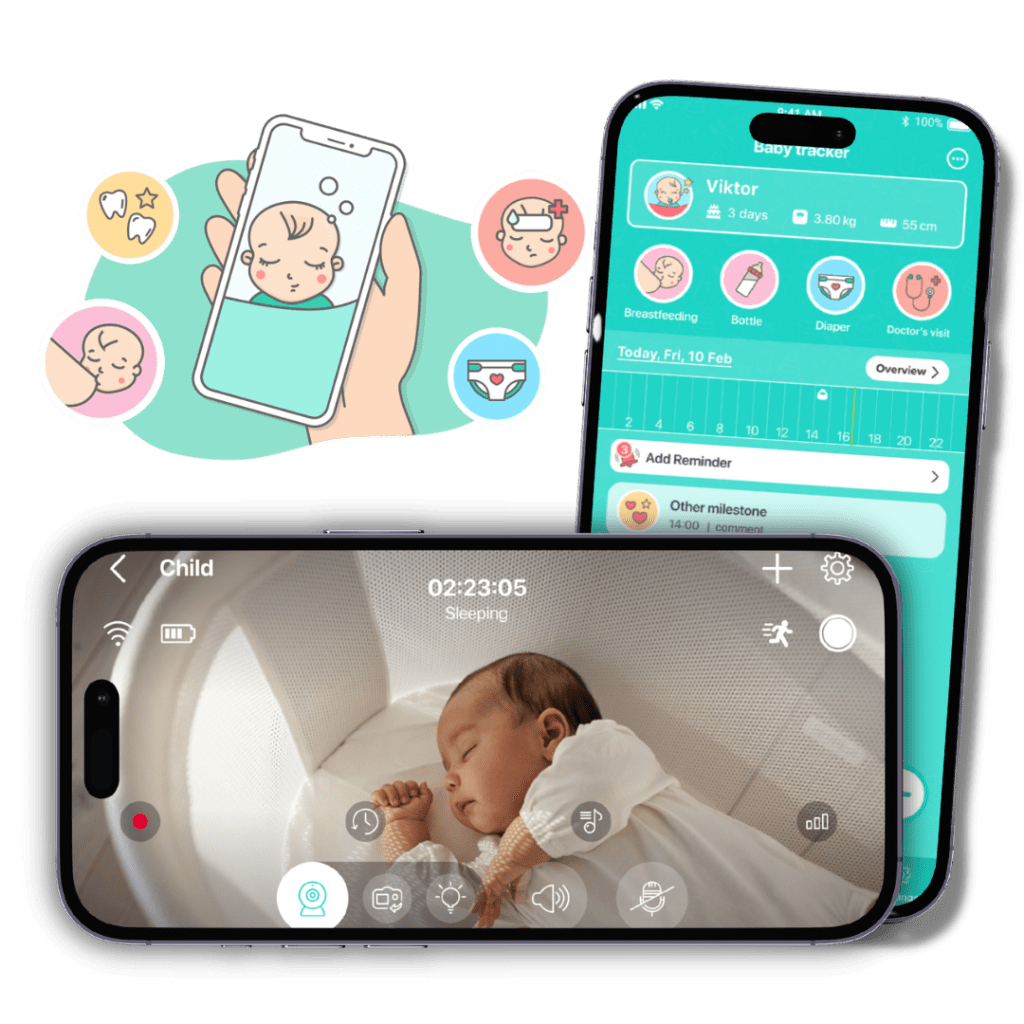
Baby’s Development – One Month Milestones
- Created:
2. 3. 2021 - Updated:
4. 10. 2023
Go to 2nd Month >>
The transition from safety in the mother’s body to free space is a sudden change – the baby needs time to get used to it. It’s called a postpartum adaptation of a newborn. The birth of a child is the most natural thing in the world, but not the easiest one.
Immediately after birth, the newborn recognizes his mother and other loved ones by voice. Within 10 days amniotic fluid is absorbed from his middle ear. Until then, he perceives the surrounding world subdued, but sharp sounds bother him.
Just a few minutes after birth, the baby thoroughly views the people and things around him, from the beginning he perceives colors and shapes. He sees best at a distance of 18-40 cm. However, the vision is not yet adapted to reality and the baby sees things in the opposite way – that means upside down. It takes time for the brain learn to rotate the things and objects that the child is looking at. He is not yet able to actively watch the object that caught his eye. This is related to the immaturity of eye movements and spatial perception. The ability to see is obtained function, and therefore it is of great importance to support its development.
Baby’s brain is fully developed at birth, nerve cells no longer form, but grow and form new connections. The experiences that the baby has already gained in the mother’s belly are multiplying – and these new experiences stimulate the formation of new connections between nerve cells in the brain.
Period immediately after childbirth is the time of the first “getting know” with the mother and the establishment of a mutual relationship. >> The First 6 Weeks After Giving Birth

Newborn Period and Baby Behavior
The newborn period lasts for the first 28 days after cutting the umbilical cord. As I wrote it is the time when baby adaptive to the world. The behavior of the newborn and his reactions take basis from reflexes and innate instincts.
The natural biorhythm is characterized by short periods of wakefulness, which are filled with activity related to satisfying biological needs.
This behavior has several common signs:
The newborn has several reflexes with different meanings:
- survival reflexes – the search and suction reflex – help with initial orientation and adaptation and are also a stepping stone to the child’s further development;
- reflexes that serve as a control of proper development – Moro’s reflex, balance reflex, grip reflex, reflex equipment for swimming movements, crawling reflex, walking reflex, etc.
The innate behavior includes the effort to perceive their surroundings and also to respond by shouting, which is a signal of the baby’s condition and needs. It is an important element of social interaction and allows the child to control his social environment in a certain way. Even at this age, crying is somewhat differentiated and carries a message – the cry of hunger is different from the cry of pain. The baby does not scream to call the mother, but when the mother responds to his scream, the child remembers it and learns to cry to get the mother’s attention by crying.
The child’s development depends on the supply of appropriate and proportionate stimuli. Every baby is different and unique, so the stimuli that interest them are different too. Some stimuli are ignored or actively rejected by the baby, on others react joyfully.

What Is Important in Upbringing in Baby’s First Month?
The main task is to mediate the child’s contact with the outside world. The opinion that it is not possible to raise a child, that any upbringing is an unnecessary overload of the child, is incorrect. Every mother subconsciously raises her child by taking care of him and satisfying his basic needs. Regular feeding, bathing, changing diapers, cuddling – all this contains many educational stimuli. The way a mother does this is very important because it creates her baby’s relationship to this stuff. At the same time, she has the opportunity to provide the baby with many visual, auditory, tactile and emotional stimuli.
The basis is therefore to develop the senses. Follow these three principles:
- supply the baby with an adequate amount of suitable sensory stimuli of various kinds,
- support some special abilities of sight and hearing – teach the baby to fix objects with sight and watch them at least for a short distance and also listen to certain sounds,
- allow the baby to know that the stimuli announce something, point something out and mean something.
Parents tend to overwhelm the baby with objects and stimuli than leaving it little bit stimulated, which is not good. Give stimuli to the baby only when is awake and reacts in a certain way. If baby more often deviates his eyes, turns his head, closes his eyes or shows aversion, it is necessary to offer the baby another stimulus or stop the stimulation and give him rest.
Important: If the toy appears suddenly and violently, it can cause frightening, fear and screaming. Also sharp movements, quick changing, or rough grip evoke negative emotional reactions. The newborn needs tender and careful treatment full of love.
Final Tip: Celebrating One-Month Milestones with Annie Baby Monitor
As your baby reaches that precious one-month mark, capture baby’s development with Annie Baby Monitor.
This baby monitor app isn’t just for monitoring; it’s a memory keeper, too.
From the first smile to those adorable coos, Annie Baby Monitor allows you to cherish these moments forever. Track a special memory to store these milestone videos or snapshots. You’ll treasure these memories for years to come.

Want to know more about tracking your baby’s growth and development? Explore our articles on how to make the most of Annie Baby Monitor.
Don’t miss out on creating lasting memories. Get your Annie Baby Monitor today and relish every moment of your baby’s journey.






